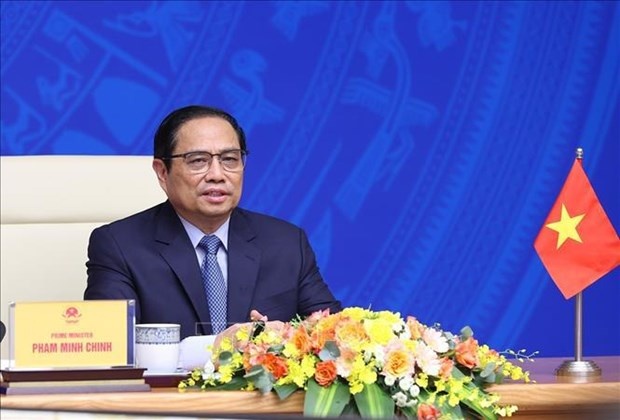Vietnam to clarify stance on US’ Indo-Pacific agenda
 |
| Prime Minister Pham Minh Chinh (Photo: VNA) |
It is expected that this week the US will hold a meeting with representatives from seven ASEAN member states, including Vietnam, on its Indo-Pacific Economic Framework for Prosperity.
Whether Vietnam will make up its mind about joining the framework (IPEF) could depend on the outcomes of the meeting, which is set to discuss concrete plans to implement the agreement, including how to boost investment and trade ties between the US and the other 12 nations involved.
US President Joe Biden in May launched the IPEF with a dozen initial partners including Australia, India, Japan, South Korea, Singapore, Vietnam, and others. Together, the countries represent 40 per cent of global GDP.
The IPEF, which focuses on the key pillars of trade, supply chains, clean energy, infrastructure, and tax, is considered an alternative to the Comprehensive and Progressive Agreement for Trans-Pacific Partnership, which the US dropped out of in 2017.
“All sides want to see a new cooperation framework featured with benefits for people and enterprises, especially small- and medium-sized ones,” said Nguyen Thi Bich Thuy, vice director of the Department for Multilateral Economy at the Vietnamese Ministry of Foreign Affairs on July 14. “Vietnam and other ASEAN nations have been meeting on the IPEF. We want to see a framework built up based on principles of openness, inclusiveness, transparency, and suitableness to international laws and the central role of ASEAN, and ensuring the best interests of Vietnam.”
At the US-ASEAN Special Summit held in May in Washington, Prime Minister Pham Minh Chinh described the bilateral relationship between Vietnam and the US as “special”, while President Biden reaffirmed the commitment of his administration to cooperate with Vietnam across many sectors including economy and trade, investment, sustainable development, and climate change.
During meetings on the sidelines of the summit with leaders of major US technology corporations, PM Chinh expected that tech group Intel would continue expanding investment in localities outside Ho Chi Minh City. Last year, Intel invested an additional $475 million in Vietnam, raising the total investment in the country to over $1.5 billion. This is the US’ largest high-tech investment in Vietnam. Intel has also committed to pumping an additional $2.6 billion in Saigon Hi-Tech Park.
While meeting with Apple CEO Tim Cook, PM Chinh suggested that Apple focus on investing in business activities in Vietnam. Apple’s main manufacturing partner, Foxconn, has invested $270 million in the northern province of Bac Giang.
According to Vietnam’s General Statistics Office, in the first half months of 2022, Vietnam’s export turnover from the US was estimated to be $55.9 billion, up 22.5 per cent on-year. Accumulatively as of June 20, total US registered investment capital in Vietnam reached $10.87 billion for nearly 1,170 valid projects, making the US the 11th biggest foreign investor in Vietnam. From January-June 20, newly-registered US capital here was $37.8 million or 10.9 per cent of the latter’s total newly-registered investment.
What the stars mean:
★ Poor ★ ★ Promising ★★★ Good ★★★★ Very good ★★★★★ Exceptional
 Tag:
Tag:
Related Contents
Latest News
More News
- 72 nations sign landmark Hanoi cybercrime convention (October 26, 2025 | 18:00)
- UN Secretary-General commends Vietnam’s global leadership (October 26, 2025 | 09:00)
- APEC finance ministers convene to tackle regional challenges (October 22, 2025 | 17:31)
- Rewiring global trade: ASEAN’s rise as supply chain hub (October 17, 2025 | 11:40)
- Vietnam attends first World Nuclear Week Forum in Russia (September 26, 2025 | 10:50)
- Vietnam attends 69th session of IAEA General Conference (September 16, 2025 | 10:00)
- ADB, WB pledge over 12 billion USD for ASEAN power grid, renewable energy projects (August 15, 2025 | 14:18)
- Lowy Institute proposes AI-based tobacco control solutions for ASEAN (August 15, 2025 | 14:14)
- Cloud computing policy to position Malaysia as regional hub by 2030 (August 15, 2025 | 14:11)
- Thailand, Cambodia suffer numerous cyber attacks (August 05, 2025 | 16:19)























 Mobile Version
Mobile Version